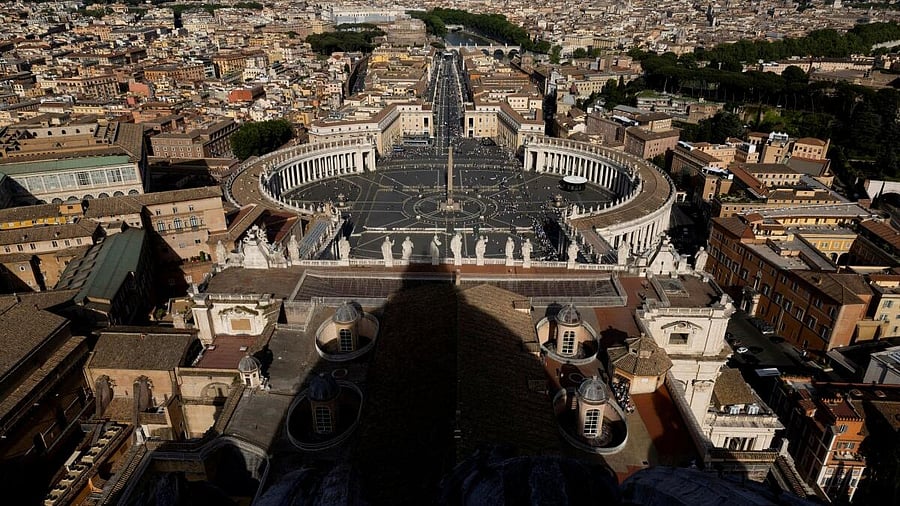
General view of Saint Peter's Square ahead of the Conclave and the election of the new Pope
Credit: Reuters Photo
By Howard Chua-Eoan
It’s been almost a half a century since questions could be shut down with the verity: “Is the Pope Italian?” In that time, the Roman Catholic Church has been led by a Pole, a German and an Argentine — the longest consecutive line of non-Italians since seven Frenchmen occupied the throne of St. Peter. And that was during the 67-year period in the 14th century when the papacy had relocated to Avignon, France. Until the 1978 election of John Paul II — born Karol Wojtyla and archbishop of Krakow — there had been 455 years of Italian popes.
As the Holy See prepares for the May 7 conclave to elect a successor to the late Pope Francis, an unofficial but authoritative list of 22 papabili (pope-ables) includes just five Italian cardinals. Indeed, the main standard-bearers for the liberal and conservative wings of the church are from Southeast Asia and West Africa, respectively: Cardinal Luis Antonio Tagle of the Philippines and Cardinal Robert Sarah of Guinea. Even if an Italian is anointed, he’ll be leading one of the most diverse and globalised of organisations, religious or otherwise: The pope is the designated spiritual and moral head of the nearly 1.4 billion people across the world who identify as Catholic. Italy isn’t even the most populous of Catholic nations. That would be Brazil.
And yet, “Is the Pope Italian?” is still a pertinent question. The chance of winning the papacy increases with the ability to speak Italian (both Tagle and Sarah are fluent). Pope John Paul II, who reigned from 1978 to 2005, famously spoke eight languages effortlessly, including Italian. His successors Benedict XVI and Francis also spoke Italian. “Does the Pope speak Italian?” will still be critical for the new pontiff. There are several reasons for this.
First, the pope is technically the bishop of Rome — the successor of St. Peter, the senior member of Jesus’s original 12 disciples. As such, his responsibilities include ministering to the parishioners of Rome. He can and does appoint auxiliaries to handle these priestly tasks but still needs to make more than occasional appearances in his immediate domain.
Second, the pope is the autocratic ruler of an independent territory encased in the capital of Italy, the remnant of a European superpower that contended with kings, emperors and sultans. It has defended this earthly prerogative with Machiavellian prowess over the centuries, if only to maintain the promise Jesus made to Peter: “Truly I tell you, whatever you bind on earth will be bound in heaven, and whatever you loose on earth will be loosed in heaven.” It was this God-given right to raise to paradise or damn to hell that helped unleash the crusades centuries ago — and perhaps helped Poles stand up to Moscow at the end of the Cold War and Filipinos to unseat a dictatorship in 1983.
The existence of the Vatican as a country involves much grubbier realpolitik. As modern Italy arose with the unification of the peninsula in the 19th century, the Papal States — ruled directly by the pontiff since the 8th century — slowly lost real estate until Pius IX, whose realm encompassed 3 million subjects and an army of 15,000 soldiers, found himself virtually barricaded in the area around Rome’s Vatican hill, where St. Peter’s Cathedral stands. He refused to recognise the new Italian state in a standoff that would last into the next four papacies. Only in 1929 did Pius XI and Benito Mussolini sign a treaty that created Vatican City as a separate country, giving the papacy earthly powers once again in exchange for papal recognition of modern Italy and financial compensation for the loss of its territories. In that historical sense, the modern papacy is inseparable from Italy.
The White House’s tasteless AI joke envisioning the US president as the next pope may actually play into the politics of the conclave — making it harder for an actual American cardinal to ascend to the papal throne. The church still remembers the long-ago Avignon papacy as a time when the pontiffs enjoyed less power having come under the sway of French monarchs. Modern cardinals are unlikely to elect a pontiff who might be manipulated by Washington, much less the American president himself — who as far as I know does not speak fluent Italian.
In any case, the intertwining of Italy and the Papacy will continue. All that historical ruthlessness involved has ironically resulted in something of a virtuous circle. The Vatican, guaranteed physical space and independence by the Italian state, remains the guardian of some of the greatest treasures of Italian art and architecture. And as the Catholic Church has become more global, all that gorgeous Italian filigree has become part of the soft power projected by the Holy See — a charisma inextricable from Italy.
There’s been talk of decoupling of the papacy from its European and Italian roots as the church grows more African, Asian and Latin American. That’s going to be hard. It is, after all, the Roman Catholic Church. And, it’s always been able to play a dual role. Over the centuries, the popes have spoken urbi et orbi — Latin for “to the city and to the world,” that is, to Rome as well as the planet. The next pope may come from outside Italy — but he will have to become Italian.